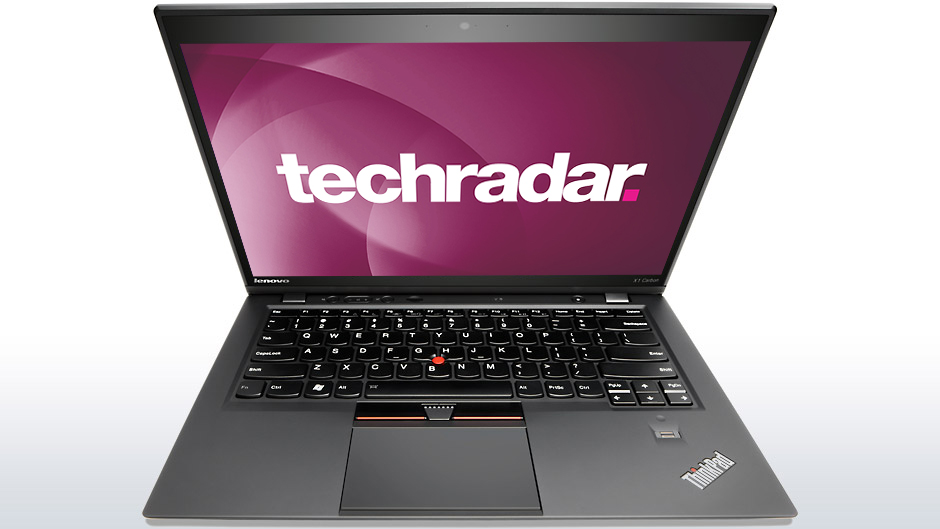TechRadar Verdict
As classy as it may be, this business ultrabook comes tough to recommend due to its hefty price tag and lackluster lasting power.
Pros
- +
Slim build
- +
Top power
- +
Decent screen
- +
Business features
- +
Lightweight
Cons
- -
No Ethernet
- -
Poor battery
- -
High price
- -
Fiddly trackpad
Why you can trust TechRadar
High performance laptops are nothing new, but until recently they were hulking beasts that could break one's back if carried out of the house. Things have changed - it's now possible to have top performance in ultra-portable packages, as demonstrated by the Lenovo ThinkPad X1 Carbon Touch Ultrabook.
It's hard to classify the Lenovo's direct competitors due to the huge variety of Windows 8 hybrids and laptops on the market. The rulebook has been ripped up and with a traditional laptop design with an added touchscreen, the Lenovo ThinkPad X1 Carbon Touch is one of the more conservative offerings. High performance laptop hybrids such as the Sony Vaio Duo 13 spring to mind, as do traditional Ultrabooks such as the Dell XPS 13 and MacBook Pro with Retina display.
The original 2012 Lenovo X1 Carbon was the best ThinkPad money could buy, but now Lenovo has added a touchscreen panel and changed Windows 7 Professional for Windows 8, bringing last year's model right up to date.
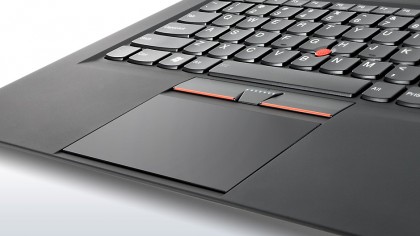
The result is a formidable machine that not only offers the best usability and performance, but also a fantastic Windows 8 experience. However, the eye-watering price tag of £1,779 / US$2,139 / AU$2,538 means this experience doesn't come cheap.
Pick the Lenovo ThinkPad X1 Carbon Touch up and it's immediately apparent that you're holding a different class of laptop. ThinkPad has always been a predominately business brand and you'll have seen the familiar black matt chassis punctuated by that red mouse pointer in Starbucks and train stations all over the place.
Being a ThinkPad, the X1 Carbon Touch retains the looks synonymous with this illustrious range, but the similarities with bog-standard corporate machines end there. Yes there's the red mouse nipple, which is bemusing when a touchscreen and full-sized trackpad are on offer, but it's an example of how important the look of the X1 Carbon Touch is to Lenovo.
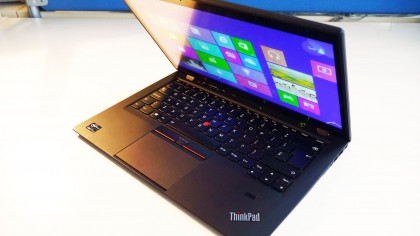
However, when you pick up the Lenovo ThinkPad X1 Carbon Touch for the first time, the solid, flexless build, smooth rubberised finish and lightweight chassis can't fail to impress. The fact that this machine weighs just 1.5kg (3.3lbs) yet counts as one of the most powerful Ultrabooks on the market speaks volumes about what Lenovo has achieved.
Other Ultrabooks that have tried to achieve this balance of weight and power have ended up scrimping on build quality - such as the HP Envy 15 with its awful trackpad or the Acer Aspire S7 and its keyboard, but the Carbon oozes quality from every port.
From the beautifully spaced and comfortable keyboard that enables immediate, accurate speed typing to the smooth and responsive trackpad to the luxurious panel that manages to marry vibrancy and clarity with a non-reflective finish.
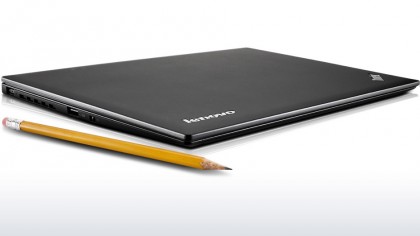
It's not just the weight - or lack of - that makes the Lenovo ThinkPad X1 Carbon Touch such a engineering triumph, it's also the thickness. Despite measuring 22mm (0.87 inches) at its thickest point - a not exactly size-zero waistline - the Carbon's wedge shape gives it the impression of blade-like thinness. It's alluring to look at and commands attention, attracting admiring comments from those around you.
However, to ace a TechRadar review, you need more than alluring looks. So let's get under the hood and see how good the Lenovo ThinkPad X1 Carbon Touch really is.
Specifications
Under the hood is an Intel Core i7 processor 3667U, the U in that pithy moniker indicating that it's one of the ultra low-power chips designed for Ultrabooks. It packs considerably more power than the likes of the Asus Zenbook or Samsung Series 9, since it's clocked at an impressive 2GHz.
The benchmark scores from our lab tests back this up too, with a top-end performance resulting in roughly 10 per cent more power than rival Ultrabooks such as the Asus Zenbook.
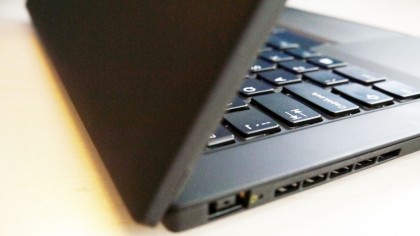
The Core i7 chip is also left to handle the graphics tasks in the absence of a dedicated graphics card. It has become the norm for manufacturers to leave 3D graphics to the onboard processor now, but it means that despite the sky-high price tag, the Lenovo ThinkPad Carbon X1 isn't the best choice for heavy video editors or gamers.
Elsewhere there's a whopping 8GB of RAM, an amount normally reserved for gaming machines or high-end powerhouses such as the Samsung Series 7 Chronos. This helps keep the Lenovo ThinkPad X1 Carbon Touch noticeably quick, helping a slick, breathless performance.
There are several models of the Lenovo ThinkPad X1 Carbon Touch at a range of price points, and our model packed a 256GB SSD drive, the highest you can get. The only criticism here is the lack of usable space, and of the 256GB on offer, only 190GB was usable.
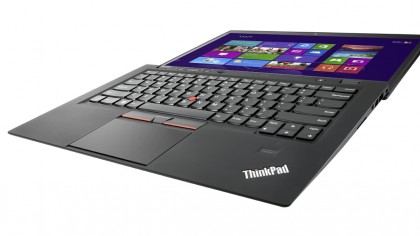
Looking at the frankly ludicrous price tag, one might be forgiven for mistakenly thinking that a dedicated graphics chip powered the Lenovo ThinkPad X1 Carbon Touch, but in a laptop this thin all the pixel-pushing has been left to that Intel Core i7 processor. It does a good job and performs better than most Ultrabooks, meaning that even the latest games are within its limitations, if you don't mind sacrificing some graphics performance.
Of course, the 14-inch, 1600 x 900 resolution panel is a key part of this updated Lenovo ThinkPad X1 Carbon Touch, and while we'd like to have seen 1080p included given the price, it's still a good performance.
The colours look great, it's pin sharp despite not being Full HD and it's as great for watching a movie as it is for working on a presentation. What's more, the touch sensitivity is as good as we've seen on a Windows 8 device, and it's miraculously free from smearing.
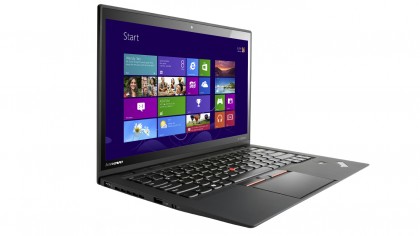
For a laptop that measures 22mm at its thickest point, connectivity is underwhelming, with two USB 3.0 ports, one of which can charge devices when the laptop is sleeping.
There's also DisplayPort for connecting to external monitors and an SD card, but no Ethernet, HDMI or VGA, which will mean carrying extra dongles to your meetings. However, business users will love the fingerprint reader and hard drive protection.
Performance
Benchmarks
Cinebench 10: 11,498
3D Mark: Ice: 32,650 Wind: 3787 Fire: 512
Battery: 192 mins
With a score of 11,498 in our processor tests, it's clear that the Lenovo ThinkPad X1 Carbon Touch is a formidable machine. This kind of score ranks among some of the best performing Ultrabooks on the market, and even manages to give the next generation of Intel processors a run for their money.
Other than top multitasking and app switching speeds, the i7 processor speeds up boot times, enabling it to go from cold to a usable Windows 8 home screen in roughly 15 seconds. Even better is the resume from sleep, which averaged around four seconds, partly due to Windows 8's improvements and of course that wickedly fast chip.
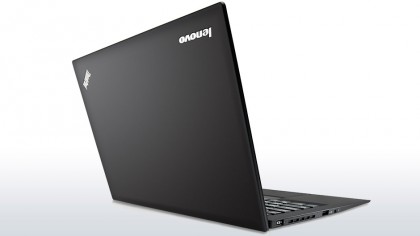
However, there's a downside. The high performance third generation Intel Core i7 chip colludes to suck power from the Lenovo ThinkPad X1 Carbon Touch, especially under heavy strain. The result is an uninspiring three hours of battery life in our test, which involves looping a high definition clip with full screen brightness until the laptop dies.
Three hours is one of the lowest Ultrabook battery scores we've seen, and should ring alarm bells for anyone who intends to use the Lenovo ThinkPad X1 Carbon Touch at high load while away from mains electricity.
Turning the screen brightness down and sticking to moderate web tasks increases lifespan to around four hours, which is still underwhelming when you consider the Samsung Vaio Duo 13 running Intel's latest Haswell fourth generation processor managed six hours in the same test.
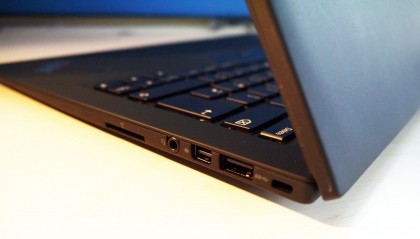
If you spend long periods on the road, you could be frustrated by the disappointing longevity, especially given the Ultrabook's sky-high price tag. Intel's new chips, announced in May and being released in earnest later this year, will offer better longevity and battery performance, which makes the £1,779 / US$2,139 / AU$2,538 price seem even less appealing.
As with most Ultrabooks there's no dedicated graphics, and while games might be playable on lower settings, it's in no way suited to overly creative tasks or heavy video editing. We wouldn't normally pull up an Ultrabook for this failing, but then most Ultrabooks don't cost this extraordinary sum.
Verdict
On the surface, the Lenovo ThinkPad X1 Carbon Touch is one of the best built and best performing laptops we've reviewed. The quality and design is stunning, and it's able to smoke even the toughest tasks with ease. However, if the high price didn't mar this performance, the below average battery life certainly does, and it hugely undermines the value of this premium device.
We liked
It may be plain black and probably won't win over Apple fanatics with its looks, but the Lenovo ThinkPad X1 Carbon Touch's alluring and premium build is one of its biggest plus points. It's a Steath Bomber, moody, dark yet devastatingly powerful with enough grunt under the hood to rival even the next generation of laptops.
We disliked
The array of business features is worth a mention as a positive, but we can't help but feel Lenovo has forgotten the basics here. As business users we missed Ethernet and a proper AV connector, and the Lenovo ThinkPad X1 Carbon Touch isn't quite slim enough to make up for the times we left the dongle at home.
However, the biggest disappointment was the frankly awful battery life. Even for a budget Ultrabook, the three hours offered here would be worthy of criticism, but at this price, it's unforgivable.
Final verdict
The Lenovo ThinkPad X1 Carbon Touch is a wonderful piece of design and engineering that offers a fearsome performance in a sleek and classy chassis. However, the staggering price and underwhelming battery life make the touchscreen Ultrabook hard to recommend.
